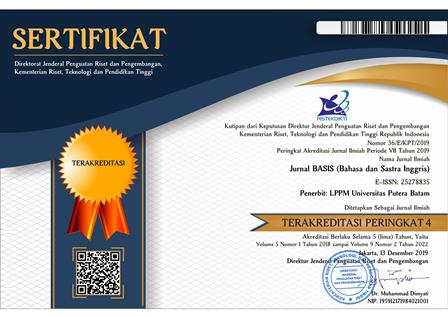THE ANALYSIS OF REPETITION AS PART OF LEXICAL COHESION IN TALK SHOWS
DOI:
https://doi.org/10.33884/basisupb.v6i1.1040Kata Kunci:
Repetition, Lexical Cohesion, Talk ShowAbstrak
Tujuan penelitian ini adalah menjabarkan lexical cohesion pada dialog. Adapun fokus penelitian ini adalah dengan melihat bentuk pengulangan yang sering terjadi dalam percakapan. Penelitian ini melihat telaah pada dialog dalam beberapa acara berbentuk talk show yang diambil dari youtube. Analisis kemudian diberikan terhadap data-data berupa dialog dari narasumber dan menyimpulkan temuan yang didapat. Penelitian ini sangat berguna terutama dalam hal membangun persepsi terhadap pendengar. Dari data yang telah dianalisis, peneliti menemukan bahwa kecenderungan pembicara adalah mengulang baik itu kata, frasa maupun kalimat yang terkadang pengulangan tersebut menjadi baik karena mempertegas sebuah pemikiran namun juga merugikan karena kalimat menjadi tidak efisien. Peneliti juga telah merangkum berbagai alasan pembicara melakukan pengulangan seperti misalnya untuk mempertegas penyampaiannya.
Referensi
Bae, J. (2001). Cohesion and Coherence in children’s written English: Immersion and English-only classes. Regents of the University of California, 12(1), 51–58.
Bailey, S. (2003). Academic writing: A practical guide for students. New York: RoutledgePalmer.
Bailey, S. (2006). Academic writing: A handbook for international students (Second Edi). New York: Routledge.
Bani-khaled, T. A. A. (2015). A discourse study of the speech “It can be otherwise” by Harvard professor and president Drew Faust. International Journal of Linguistics, 7(6), 1–18. https://doi.org/10.5296/ijl.v7i6.8372
Corssley, S. A., & McNamara, D. S. (2016). Say more and be more coherent: How text elaboration and cohesion can increase writing quality. Journal of Writing Research, 7(3), 351–370. https://doi.org/10.17239/jowr-2016.07.03.02
Ellis, C. E. al. (2005). Recovery of cohesion in descriptive discourse after left-hemisphere stroke. Journal of Rehabilitation Research & Development, 42(6), 737–746.
Gay, L. ., Mills, G. E., & Airasian, P. (2009). Educational research: Competencies for analysis and applications. New Jersey: Pearson Education.
Gerot, L., & Wignell, P. (1994). Making sense of functional grammar: An introductory workbook. Sydney: Gerd Stabler.
Halliday, M. A. ., & Hasan, R. (1976). Cohesion in English. London: Longman Group Limited.
Halliday, M. A. K., & Matthiessen, C. (2004). An Introduction to functional grammar (3rd editio). London: Arnold.
Hinkel, E. (2004). Teaching academic ESL writing: Practical techniques in vocabulary and grammar. New Jersey: Lawrence Erlbaum Associates, Inc.
Knapp, P., & Watkins, M. (2005). Genre, text, grammar: Technologies for teaching and assessing writing. Sydney: UNSW Press.
Kurniawan, E., & Utami, A. D. (2017). The representation of Joko Widodo’s figure in the Jakarta Post. Indonesian Journal of Applied Linguistics, 6(2), 341–350. https://doi.org/dx.doi.org/10.17509/ijal.v6i2.4918
Manipuspika, Y. S. (2014). Accomplishing coherence in talk shows: A comparison between English and Indonesian. Indonesian Journal of Applied Linguistics, 3(2), 154–168.
Matthews, P. . (2007). The concise Oxford dictionary of linguistics. Oxford: Oxford University Press.
Mubarak, Z. H. (2013). An analysis of students’ ability in building cohesion and coherence in argumentative essays written by the fourth year students of English Department at University of Bengkulu. English Language Teaching, 1(3), 30–42.
Patriana, A. W., Rachmajanti, S., & Mukminatien, N. (2016). Students’ ability in using discourse markers to build coherence in compositions. TEFLIN Journal, 27(2), 203–216. https://doi.org/dx.doi.org/10.15639/teflinjournal.v27i2/203-216
Renkema, J. (2004). Introduction to discourse studies. Amsterdam/Philadelphia: John Benjamins Publishing Company.
Sakhiyya, Z. (2017). Negotiating social identity through questions in casual conversations: A critical discourse analysis. Indonesian Journal of Applied Linguistics, 6(2), 311–318. https://doi.org/dx.doi.org/10.17509/ijal.v6i2.4916
Satori, D., & Komariah, A. (2011). Metodologi penelitian kualitatif. Bandung: Alfabeta.
Suwandi. (2016). Coherence and cohesion: An analysis of the final project abstracs of the undergraduate students of PGRI Semarang. Indonesian Journal of Applied Linguistics, 5(2), 253–261. https://doi.org/10.17509/ijal.v5i2.1349
Taboada, M. T. (2004). Building coherence and cohesion: Task-oriented dialogue in English and Spanish. Amsterdam/Philadelphia: John Benjamins Publishing Company.
Tanskanen, S.-K. (2006). Collaborating towards coherence: Lexical cohesion in English discourse. Amsterdam/Philadelphia: John Benjamins Publishing Company.
Yeh, C. (2004). The relationship of cohesion and coherence : A contrastive study of English and Chinese. Journal of Language and Linguistics, 3(2), 243–260.
Zemach, D. ., & Rumisek, L. . (2003). College writing: From paragraph to essay. Oxford: Macmillan Publisher Limited.
Zemach, D. ., & Rumisek, L. . (2005). Academic writing: From paragraph to essay. Oxford: Macmillan Publisher.
##submission.downloads##
Diterbitkan
Terbitan
Bagian
Lisensi













 JURNAL BASIS (BAHASA DAN SASTRA INGGRIS)
JURNAL BASIS (BAHASA DAN SASTRA INGGRIS)
